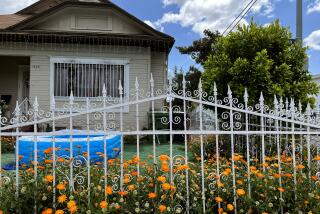From the beginning, they were a civic...
From the beginning, they were a civic odd couple. Hynes was an unincorporated suburb famous for its dairies, and Clearwater was known--rather improbably--for its dry lake. All the two enclaves really had in common was the boulevard that crossed them both. So when they merged in 1957, the city was given a new name: Paramount.
Settled by a wave of Dutch and Portuguese immigrants after World War I, the area grew into a bustling agricultural center and became know as the “Hay Capital of the World” because of its role as the nation’s largest receiving point for hay.
Even before the town incorporated, residents began flocking to an elite area in western Paramount known as the Sans, where 11 streets with saintly names such as San Juan, San Vicente and San Luis came to dead ends at the Los Angeles River. Years later, the neighborhood would be hit hard by gangs, drugs and late-night gunfire.
By the 1960s, dairies began giving way to housing subdivisions and industry left--as did many longtime white residents, who were replaced by working-class Latino families. The city was embarrassed in 1982 when a Rand Corp. report based on socioeconomic data put Paramount on a list of eight cities it declared “disaster areas.”
Paramount fired back with an ambitious redevelopment plan that helped spruce up the decayed downtown corridor with tidy shopping strips and new housing.
In 1986, despite cries of racism, city leaders sought to create a new image by changing the name of a two-mile stretch of Compton Boulevard to Somerset Boulevard. Housing developers had advised that disassociating from the city of Compton would lure more middle-income residents.
Paramount is no longer the hub of Dutch activity. But the Dutch influence is still evident in yards landscaped with windmills and social clubs. More than 200 members of Emmanuel Reformed Church are of Dutch ancestry, and residents with surnames such as Feenstra, Boogaard and Romberg are scattered throughout the town.
Paramount Inside Out
ICING ON THE CAKE: A central Paramount attraction is the Iceland Skating Rink, which was the largest rink in Southern California when it opened in 1939. Its owner, the late Frank Zamboni, invented the Zamboni ice resurfacing machine, which is still manufactured in town, and his rink was used by Olympic champion Sonja Henie to rehearse her ice revues. A skeletal chassis of the prototype is housed in a shrine in a corner of the rink.
WORLD’S TOUGHEST PARKING ENFORCEMENT: In 1990, the Paramount Lions Club received permission from the city to install a cautionary holiday display in a vacant lot, consisting of a wrecked automobile and a “Don’t Drink and Drive” sign. A few weeks later, an enthusiastic traffic officer--not noticing the sign--slapped the battered heap with a citation, giving the owner 72 hours to remove it or face towing charges. City officials later rescinded the warning.
SHOPPERS’ MECCA: The largest daily swap meet in the state has been held at the old Paramount Drive-In Theater on Paramount Boulevard near Rosecrans Avenue since 1955. The 800-merchant marketplace offers new and used merchandise and attracts an estimated 75,000 shoppers a week.
BAR NONE: Disenchanted with the American Bar Assn., four lawyers formed the Paramount Bar Assn. in 1984, the smallest unrecognized such group in the nation. Today, it still has only four members.
MUNICIPAL MIRACLES: In 1988, six years after a less-than-flattering Rand Corp. report, Paramount’s civic pride was boosted when it was designated an All-American City by the National Civic League. The city was cited for three programs: the Alternative to Gang Membership Program, Neighborhoods Lookin’ Good and a program that allowed residents to turn in evaluation cards on the performance of sheriff’s deputies. Last November, Paramount won another award for a crime-control program called Victory Over Violence.
CRIMES MOST FOWL: More than a year ago, city workers hung notices on the doorknobs of residents warning that because of a “large number of complaints . . . the city will begin confiscating any chickens or roosters that are wandering loose in the streets or other public places.” No use putting them on a leash, because the notice also added that it’s against the law to be in possession of live poultry anywhere in the city.
More to Read
Sign up for Essential California
The most important California stories and recommendations in your inbox every morning.
You may occasionally receive promotional content from the Los Angeles Times.










